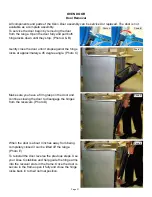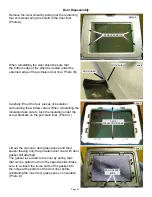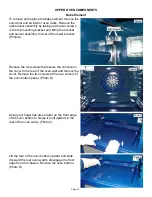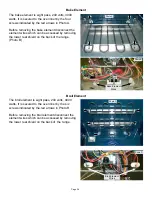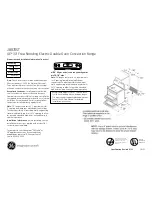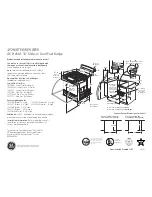
Page 24
VARIABLE SPEED CONTROL
To achieve optimum cooking results during convection cooking the fan motor speed can be varied.
The EOC will signal the VSC board to speed up or slow down the fan as needed. This speed change
takes place automatically with no action required by the consumer.
The Variable Speed Control (VSC) board operates the Convection Fan as well as the Oven
LUXURY™ lighting. In the event that either of these features do not operate properly the VSC board
should be examined as a possible source of failure. When testing for convection fan operation it
should be noted that on gas ranges there is a six minute delay from the start of the convection
cooking cycle until the fan motor will run.
Variable Fan Speed
The VSC Board is located on the rear of the range
just below the power supply boards, as seen
in photo A. The board varies the voltage to the
convection fan motor as directed by the EOC to
alter the motor speed. The speed control signal and
the power supply to operate the VSC board come
from the EOC through a wiring harness connected
between P2 on the EOC and P1 on the VSC board.
This harness must be intact and properly connected
for the VSC board to operate. If the harness is
defective or not properly connected the EOC will
display a fault code F23.
When testing the VSC board the power supply from
the EOC to the board can be verified by measuring
the voltage between pins 1 & 6 (the two outside pins)
on connector P6 of the VSC board. This connector is
not wired in field applications and the pins are easily
accessed to test voltage while the other harness
connectors are in place and power is applied to
the range. Test for approximately 5 volts DC (+/-
.5 volt) on these two pins. If the EOC appears to
operate normally but the voltage to the VSC board is
incorrect or if there is no voltage present inspect and
test the wire harness and connectors between the
EOC and VSC board. If the harness is good then the
EOC is defective and should be replaced.
P6
P2
Photo B
P1
Pin 1
Pin 6
If the convection fan motor fails to run test for voltage to the convection fan motor. If no voltage is
present then the failure is either in the VSC board, EOC , or the wiring in between. If there is proper
voltage to the fan motor but it does not run then either the motor windings are open or the motor is
stuck. Test the continuity of the motor windings with an ohm meter. There should be approximately
15 ohms of resistance in the convection fan motor windings. If the windings test good inspect the fan
blade and motor shaft to see if the motor will turn. Adjust the fan blade to eliminate binding or replace
the motor assembly if the motor shaft is seized.
Photo A
VSC Board
Summary of Contents for CEI30EF5GB
Page 11: ...Page 11 Wiring Diagram Electric Wave Touch Models with Lower Oven ...
Page 12: ...Page 12 Schematic Diagram Electric WaveTouch Models with Lower Oven ...
Page 13: ...Page 13 Wiring Diagram Electric IQ Touch Models with Warming Drawer ...
Page 14: ...Page 14 Schematic Diagram Electric IQ Touch Models with Warming Drawer ...
Page 46: ...Page 46 ...
Page 47: ...Page 47 NOTES ...






















